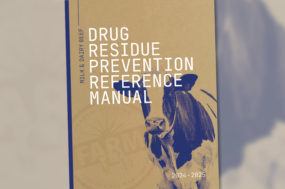About 10 years ago, I was working in another country and asked a question of a nutritionist I had known for 10 years previously: “What fat supplementation are you providing?” I was surprised when she said after about five years experience with high palmitic fatty acid (HPFA) supplementation, they no longer used that supplement.
When I asked why, she noted increased milkfat percentage but lower dry matter intake (DMI) and poorer body condition. More to these points later, but first let’s establish some key aspects of fatty acid (FA) supplementation to dairy cows.
- The cow’s system is set up to use FAs, not triglycerides. Unless the triglycerides fed have too high a melting point for the rumen, the microbes will hydrolyze the triglycerides to free fatty acids (FFA) and glycerol.
- If the FAs are unsaturated, the microbes will then saturate or biohydrogenate them because unsaturated FAs are toxic to the microbes.
- Most of the FAs consumed by dairy cows are primarily palmitic (C16:0), stearic (C18:0), oleic (C18:1), linoleic (C18:2) and linolenic (C18:3).
- Lipids leaving the rumen are 85% to 90% FFA, 66% stearic, 33% palmitic, and 10% to 15% are phospholipids – microbial cell walls. Lipids in milk are about 65% saturated (40% palmitic, stearic, myristic) and 35% unsaturated (66% oleic, linoleic, linolenic). The oleic in milkfat comes not from the diet but primarily from the mammary gland desaturating stearic to oleic.
- About 75% of unsaturated FAs are biohydrogenated in the rumen to saturated FAs. For example, oleic would be biohydrogenated to stearic.
- Unsaturated FAs decrease DMI. The best example of this is from calcium salts of fatty acids. It is not the calcium salts per se which results in this deceased DMI, but rather that is due to the unsaturated FA composition of the calcium salts. This relationship was incorporated mathematically into the 2001 Dairy NRC in that calcium salts decreased DMI by 2.5% for each percentage unit in the diet above the control.
The primary FAs used in non-calcium salts of FAs are palmitic and stearic. These two FAs were reviewed extensively in 2014 in the Journal of Dairy Science. They noted the following characteristics of each of these FAs (see sidebar).
The burgeoning palm oil business in southeast Asia generated palmitic FAs which have increasingly been imported into the U.S. over the last 10 years and often at a favorable price compared to stearic/palmitic blends. This has spawned a number of research trials, primarily at one university.
In turn, this has resulted in questions about HPFA supplementation (generally 80% palmitic or greater), some of which are related to comments by the nutritionist noted at the beginning of this article. It has been found that higher levels (80%) of either stearic or palmitic increases their crystallinity, which can reduce their digestibility – but this does not seem to occur when a blend of these two FAs is prilled. Here are some categories of issues and questions:
Milkfat percentage increase
Most studies done with HPFA supplements show an increase of about 0.1% to 0.3% milkfat. But a regression of palmitic intake (range of 0.2 to 2 pounds per cow per day) only had a R2 of 0.34. That means the regression only represented about one-third of the variation in milkfat. What were the sources of the other two-thirds variation in milkfat?
NDF and total FA digestibility
The area of FA impact on neutral detergent fiber (NDF) digestibility is debatable and not corroborated by other research groups. Questions are about NDF and fatty acid assay methodology, possible mode of action, and only about 50% of the variation (R2 = 0.54) was accounted for by palmitic intake and NDF digestibility. What accounts for the other 50% variation? What would this regression look like with other C16 and C18 fatty acids?
Ruminal biohydrogenation of oleic
The extent of ruminal biohydrogenation of oleic to stearic, and how much oleic survives the rumen is not often acknowledged. Several studies indicate only about 15% to 25% of dietary oleic survives ruminal biohydrogenation to stearic. If 20 to 60 grams oleic post-ruminal is optimal, feeding 100 to 300 grams oleic would be needed to provide that amount post-ruminal. How could that be done? Calcium salts have been shown to not protect against ruminal biohydrogenation of unsaturated FAs.
Length of studies and stage of lactation
Many of the studies have been 21-day periods with mid-lactation cows. One study was titled as a long-term study, but five weeks is not long-term. However, it is a longer term than the various 21-day studies. Another study was billed as a longer-term study of 10 weeks, but not of 15 or 16 consecutive weeks, which would cover the first third of a 305-day lactation. Why do many of the studies not include another fat supplement treatment so the study is not simply no-fat versus palmitic? That would have provided more comparative FA supplement data. The complementary effects of palmitic and stearic fatty acids in a supplement were reviewed in a 2014 study.
Oleic fatty acid supplementation
Reviewing published papers revealed a palmitic plus oleic treatment had lower DMI than the other two fat supplements in a study. Why? Data was interpreted that increasing oleic in place of palmitic was more beneficial. But since approximately 80% of oleic is biohydrogenated in the rumen to stearic, it can also be interpreted that the benefits were due to stearic – not to oleic per se. Furthermore, another interpretation is that decreasing palmitic was the reason for beneficial responses. Why would that be?
Why do HPFA supplements consistently decrease DMI?
A review of palmitic treatments versus non-fat controls in various studies yielded negative DMI from HPFA supplementation nine times, positive DMI four times and no effect on DMI six times. There are also two Penn State studies which showed negative effects on DMI with high palmitic supplementation. In addition, a 2017 meta-analysis found an average DMI decrease of 1.2 pounds per cow daily for palmitic versus non-fat control.
At the May 2019 ADSA Discover Conference, a question was raised as to whether decreased DMI with calcium salts of FAs (which most commonly use palm FA distillate) might be due to linoleic, palmitoleic or palmitic levels? As HPFA supplements also decrease DMI, maybe the decreased DMI with calcium salts is also due to the HPFA content in palm fatty acid distillate? A study by West Virginia and Michigan State universities had found higher palmitic may increase ceramide formation and affect insulin – and these factors may be related to mechanisms for high palmitic decreasing DMI.
What about NEFAs?
When cows maintain milk production in the face of decreased DMI due to fat supplements, they typically do this by mobilizing some body condition which increases blood NEFAs. This occurred with a key study using calcium salts and in a few other studies with HPFA supplementation where NEFAs were measured, that also occurred to varying degrees, including in earlier lactation. Cows need to replenish lost body condition at some point.
Nature of TMR and basal fat levels
A question was raised at the May 2019 ADSA Discover Conference about TMR formulations used as to why many studies often used atypical diets for mid-lactation cows? For instance, a commonly used TMR contained 22% corn silage, 15% alfalfa silage, 4.6% wheat straw and 7% whole cottonseed. That calculates only about 37% forage, and even with the added wheat straw is slightly over 40% roughage. Baseline fatty acids in that TMR with the 7% whole cottonseed was about 3.4%. Why was 7% whole cottonseed also used?
Circling back to the nutritionist’s comments at the beginning of this article, what should be the takeaway points? In feeding FAs to lactating dairy cows, avoid or diminish feeding unsaturated fatty acids, avoid high levels (greater than 80%) of stearic or palmitic FAs fed individually, and strive for a blend of stearic and palmitic FAs as supported by extensive research trials and a key literature review.
This should provide the optimal benefits to the cow in terms of no DMI decrease, response in milk production and components, and maintaining body condition.
References omitted but are available upon request by sending an email to an editor.
Stearic and palmitic fatty acids
Stearic
- Located throughout tissues – provides for cow’s many energy needs
- Does not accumulate in the liver, nor contribute to DMI decrease
- Used as the source for conversion to oleic (C18:1) – the cow creates 90% in milkfat
- Tends to increase milkfat percentage but does not decrease shorter-chain fatty acids
- Helps milk production and possibly milk protein synthesis too
Palmitic
- Very poorly absorbed into adipose (fat) tissues
- Can accumulate in liver and impair glucose synthesis – milk production
- Can be oxidized to produce energy for the cow, but liver accumulation and oxidation can decrease DMI via ceramides
- Helps increase milkfat percentage but this is partially offset by decreased shorter-chain fatty acids





